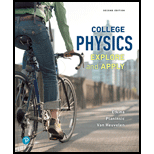
Concept explainers
Electric accelerator A micro-transporter moves from one side of an evacuated chamber to another It is powered by equal-magnitude, opposite-sign charges Q and –Q on top of two station points (see Figure P17.45). If a

Want to see the full answer?
Check out a sample textbook solution
Chapter 17 Solutions
College Physics
Additional Science Textbook Solutions
Physics: Principles with Applications
Physics (5th Edition)
Essential University Physics (3rd Edition)
Introduction to Electrodynamics
Essential University Physics: Volume 2 (3rd Edition)
Physics for Scientists and Engineers: A Strategic Approach, Vol. 1 (Chs 1-21) (4th Edition)
- Review. Two insulating spheres have radii r1 and r2, masses m1 and m2, and uniformly distributed charges q1 and q2. They are released from rest when their centers are separated by a distance d. (a) How fast is each moving when they collide? (b) What If? If the spheres were conductors, would their speeds be greater or less than those calculated in part (a)? Explain.arrow_forwardFour charged particles are at rest at the corners of a square (Fig. P26.14). The net charges are q1 = q2 = 2.65 C and q3 = q4 = 5.15 C. The distance between particle 1 and particle 3 is r13 = 1.75 cm. a. What is the electric potential energy of the four-particle system? b. If the particles are released from rest, what will happen to the system? In particular, what will happen to the systems kinetic energy as their separations become infinite? FIGURE P26.14 Problems 14, 15, and 16.arrow_forwardUnreasonable results (a) Two 0.500 g raindrops in a thunderhead are 1.00 cm apart when they each acquire 1.00 mC charges. Find their acceleration. (b) What is unreasonable about this result? (c) Which premise or assumption is responsible?arrow_forward
- FIGURE P26.14 Problems 14, 15, and 16. Four charged particles are at rest at the corners of a square (Fig. P26.14). The net charges are q1 = q2 = 2.65 C and q3 = q4 = 5.15 C. The distance between particle 1 and particle 3 is r13 = 1.75 cm. a. What is the electric potential energy of the four-particle system? b. If the particles are released from rest, what will happen to the system? In particular, what will happen to the systems kinetic energy as their separations become infinite?arrow_forwardReview. Two insulating spheres have radii 0.300 cm and 0.500 cm, masses 0.100 kg and 0.700 kg, and uniformly distributed charges 2.00 C and 3.00 C. They are released from rest when their centers are separated by 1.00 m. (a) How fast will each be moving when they collide? (b) What If? If the spheres were conductors, would the speeds be greater or less than those calculated in part (a)? Explain.arrow_forwardOppositely charged parallel plates are separated by 5.33 mm. A potential difference of 600 V exists between the plates. (a) What is the magnitude of the electric field between the plates? (b) What is the magnitude of the force on an electron between the plates? (c) How much work must be done on the electron to move it to the negative plate if it is initially positioned 2.90 mm from the positive plate?arrow_forward
- Rank the potential energies of the four systems of particles shown in Figure CQ16.4 from largest to smallest. Include equalities if appropriate. Figure CQ16.4arrow_forwardA proton accelerates from rest in a uniform electric field of 640. N/C At some later time, its speed is 1.20 106 m/s. (a) Find the magnitude of the acceleration of the proton. (b) How long does it take the proton to reach this speed? (c) How far has it moved in that interval? (d) What is its kinetic energy at the later time?arrow_forwardOne end of a light spring with force constant k = 125 N/m is attached to a wall, and the other end to a metal block with charge qA = 2.00 C on a horizontal, frictionless table (Fig. P23.34). A second block with charge qB = 3.60 C is brought close to the first block. The spring stretches as the blocks attract each other so that at equilibrium, the blocks are separated by a distance d = 12.0 cm. What is the displacement x of the spring? Figure P23.34arrow_forward
- (a) Calculate the number of electrons in a small, electrically neutral silver pin that has a mass of 10.0 g. Silver has 47 electrons per atom, and its molar mass is 107.87 g/mol. (b) Imagine adding electrons to the pin until the negative charge has the very large value 1.00 mC. How many electrons are added for every 109 electrons already present?arrow_forwardFor a system consisting of two identical negatively charged particles, sketch UE versus r and VE versus r. Comment on your graphs.arrow_forward(a) Find the electric potential difference Ve required to stop an electron (called a stopping potential) moving with an initial speed of 2.85 107 m/s. (b) Would a proton traveling at the same speed require a greater or lesser magnitude of electric potential difference? Explain. (c) Find a symbolic expression for the ratio of the proton stopping potential and the electron stopping potential. Vp/Ve.arrow_forward
 College PhysicsPhysicsISBN:9781285737027Author:Raymond A. Serway, Chris VuillePublisher:Cengage Learning
College PhysicsPhysicsISBN:9781285737027Author:Raymond A. Serway, Chris VuillePublisher:Cengage Learning Physics for Scientists and EngineersPhysicsISBN:9781337553278Author:Raymond A. Serway, John W. JewettPublisher:Cengage Learning
Physics for Scientists and EngineersPhysicsISBN:9781337553278Author:Raymond A. Serway, John W. JewettPublisher:Cengage Learning Physics for Scientists and Engineers with Modern ...PhysicsISBN:9781337553292Author:Raymond A. Serway, John W. JewettPublisher:Cengage Learning
Physics for Scientists and Engineers with Modern ...PhysicsISBN:9781337553292Author:Raymond A. Serway, John W. JewettPublisher:Cengage Learning College PhysicsPhysicsISBN:9781305952300Author:Raymond A. Serway, Chris VuillePublisher:Cengage Learning
College PhysicsPhysicsISBN:9781305952300Author:Raymond A. Serway, Chris VuillePublisher:Cengage Learning Principles of Physics: A Calculus-Based TextPhysicsISBN:9781133104261Author:Raymond A. Serway, John W. JewettPublisher:Cengage Learning
Principles of Physics: A Calculus-Based TextPhysicsISBN:9781133104261Author:Raymond A. Serway, John W. JewettPublisher:Cengage Learning Physics for Scientists and Engineers: Foundations...PhysicsISBN:9781133939146Author:Katz, Debora M.Publisher:Cengage Learning
Physics for Scientists and Engineers: Foundations...PhysicsISBN:9781133939146Author:Katz, Debora M.Publisher:Cengage Learning





